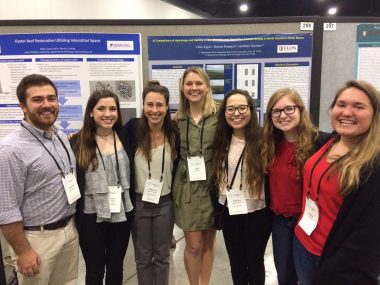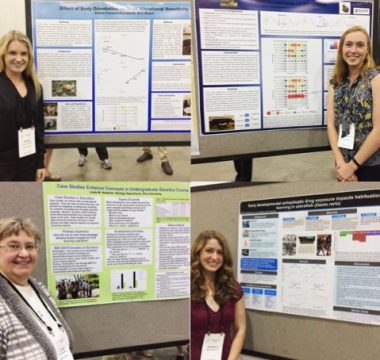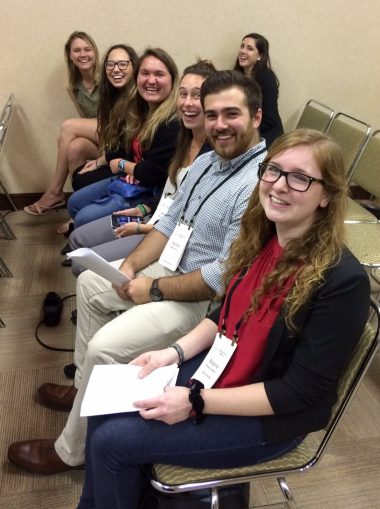Five faculty members and eleven undergraduate researchers from the Biology and Environmental Studies departments represented Elon University at the Association of Southeastern Biologists conference at the Myrtle Beach Convention Center on March 28-30, 2018.
Five faculty members and eleven undergraduate researchers from the Biology and Environmental Studies departments represented Elon University at the Association of Southeastern Biologists conference at the Myrtle Beach Convention Center on March 28-30, 2018.
 Student researchers included Breanna Coughlin ’18, Chloe Eggert ‘20, Alina Iwan ’19, Mariana Kneppers ‘18, Emma Lavandosky ‘18, Kylie Roehrle ‘19, Ellen Montgomery ’18, Matthew Sears ‘18, Sydney Solomon ’19, Sophia Tesluk ’18 and Madeleine Wetterhall ‘18. Faculty attendees included Assistant Professor Eric Bauer, Assistant Professor Jen Hamel, Associate Professor Linda Niedziela, Professor Brant Touchette, and Associate Professor David Vandermast.
Student researchers included Breanna Coughlin ’18, Chloe Eggert ‘20, Alina Iwan ’19, Mariana Kneppers ‘18, Emma Lavandosky ‘18, Kylie Roehrle ‘19, Ellen Montgomery ’18, Matthew Sears ‘18, Sydney Solomon ’19, Sophia Tesluk ’18 and Madeleine Wetterhall ‘18. Faculty attendees included Assistant Professor Eric Bauer, Assistant Professor Jen Hamel, Associate Professor Linda Niedziela, Professor Brant Touchette, and Associate Professor David Vandermast.
In addition to attending the poster sessions and research talks in ecology, behavior, microbiology and science education, Elon students and faculty also presented their own work.
Coughlin gave an oral presentation, “Examining treehopper maternal vibrational signals during simulated predator attacks.” Although most insect species communicate via substrate vibrations, little is known about this kind of communication. Coughlin showed that females of a plant-feeding insect species that tend their offspring produce vibrational signals during predator attacks, and that behavior and signal parameters are very consistent among females. Her work adds to growing evidence suggesting that many insects use this form of communication to meet ecological challenges.
 Eggert presented a poster, “A comparison of hydrology and salinity in salt marshes and vegetative coastal-swales in North Carolina’s Outer Banks.” Eggert sought to understand how some salt marsh plants can also inhabit inland-coastal swales. Her results suggest that plant adaptations to physiological stress associated with high salinity may also provide a level of drought tolerance in plants residing in dryer-sandy swale soils.
Eggert presented a poster, “A comparison of hydrology and salinity in salt marshes and vegetative coastal-swales in North Carolina’s Outer Banks.” Eggert sought to understand how some salt marsh plants can also inhabit inland-coastal swales. Her results suggest that plant adaptations to physiological stress associated with high salinity may also provide a level of drought tolerance in plants residing in dryer-sandy swale soils.
Kneppers presented a poster, “Acclimation to elevated salinities promotes photosystem II thermoprotection in salt marsh plants.” Kneppers found that plants acclimated to low salinities were less tolerant to heat shock. Her work suggests that higher-marsh plants that have lower interactions with environmental salts may be more susceptible to rising global temperatures.
 Lavandosky presented a poster, “Effect of body orientation on vibrational sensitivity of the terrestrial snail Helix pomatia.” Little is known about the sensory world of snails, including whether they can detect and respond to vibrations in the soil or leaf litter over which they are moving. Lavandosky showed that snails positioned on a vertical surface (such as a plant stem) are sensitive to vibrations, though they are selective as to which vibrations they respond to. Her research group will now expand this study as well as see if vibrations produced by predators match the demonstrated sensitivity of snails.
Lavandosky presented a poster, “Effect of body orientation on vibrational sensitivity of the terrestrial snail Helix pomatia.” Little is known about the sensory world of snails, including whether they can detect and respond to vibrations in the soil or leaf litter over which they are moving. Lavandosky showed that snails positioned on a vertical surface (such as a plant stem) are sensitive to vibrations, though they are selective as to which vibrations they respond to. Her research group will now expand this study as well as see if vibrations produced by predators match the demonstrated sensitivity of snails.
Montgomery presented a poster, “Vibrational behavioral sensitivity of the terrestrial snail Helix pomatia.” Lavandosky’s and Montgomery’s experiments are complementary in that Montogomery is researching snails on a horizontal surface (such as a plant leaf). Montgomery found that snails are more sensitive to vibrations when on a flat surface. By training snails, she showed that snails can detect weak vibrations that may not ordinarily evoke an outwardly observable response. Her research group will continue to map out the limits of vibration detection using this training technique.
 Sears gave an oral presentation titled, “Investigating the reproductive outcomes of prolonged copulations in Anasa tristis.” Within insects, copulation durations vary widely, and findings about how durations affect the number and quality of offspring produced are inconsistent. Sears documented copulation durations for a common agricultural pest insect and tested the effects of duration on female fecundity, fertility and longevity. His findings suggest that in this species, prolonged copulations do not benefit females, and multiple copulations may reduce female fertility and longevity.
Sears gave an oral presentation titled, “Investigating the reproductive outcomes of prolonged copulations in Anasa tristis.” Within insects, copulation durations vary widely, and findings about how durations affect the number and quality of offspring produced are inconsistent. Sears documented copulation durations for a common agricultural pest insect and tested the effects of duration on female fecundity, fertility and longevity. His findings suggest that in this species, prolonged copulations do not benefit females, and multiple copulations may reduce female fertility and longevity.
Tesluk presented a poster, “Soil Characteristics and abundances of seeded prairie species in central North Carolina”, showcasing data that she collected at Elon University Loy Farm. Tesluk showed that Loy Farm’s prairie is much like natural prairies in that small-scale variations in soil water availability influence the abundances of seeded plants.
Wetterhall presented a poster, “Impact of antiepileptic drugs on habituation learning in zebrafish (Danio rerio).” Antiepileptic drugs, while effective at treating epilepsy, can have a negative effect on cognition and learning. Wetterhall investigated drugs with different mechanisms of action trying to find a correlation between mechanism and the level of cognitive deficit. However, while different drugs showed differences in their negative impacts, the differences were too small to relate them to specific mechanisms.
Niedziela presented a poster, “Case studies enhance basic concepts in undergraduate genetics course”, explaining an approach she developed during a recent sabbatical for teaching genetics using a set of case studies. The cases were chosen to reinforce six difficult-to-teach concepts. Her preliminary data support the fact that students responded positively to the use of cases. Future studies will investigate objective learning outcomes to determine if the cases are effective for students learning.
Coughlin and Sears are mentored in research by Hamel. Eggert and Kneppers are mentored by Touchette. Lavandosky and Montgomery are mentored by Bauer. Tesluk is mentored by Vandermast. Wetterhall is mentored by Niedziela.
Niedziela, Hamel, and Vandermast also served as judges for student talks and posters.


